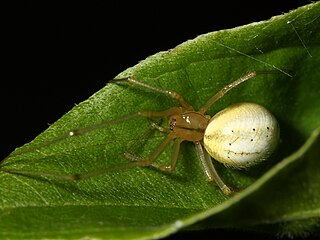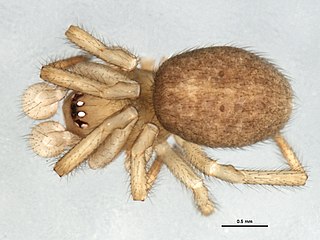
Theridiidae, also known as the tangle-web spiders, cobweb spiders and comb-footed spiders, is a large family of araneomorph spiders first described by Carl Jakob Sundevall in 1833. This diverse, globally distributed family includes over 3,000 species in 124 genera, and is the most common arthropod found in human dwellings throughout the world.

Rugathodes is a genus of comb-footed spiders that was first described by Allan Frost Archer in 1950. It is closely related to members of Theridion and Wamba.
Ceratinella is a genus of dwarf spiders that was first described by James Henry Emerton in 1882. They are very similar to both Ceraticelus and Idionella, and the taxonomy of these spiders may change.
Anatolidion is a monotypic genus of comb-footed spiders containing the single species, Anatolidion gentile. It was first described by J. Wunderlich in 2008, and is found in Africa and Europe.

Platnickina is a genus of comb-footed spiders that was first described by A. Ö. Koçak & M. Kemal in 2008.

Agyneta is a genus of dwarf spiders that was first described by J. E. Hull in 1911.

Robertus is a genus of comb-footed spiders that was first described by Octavius Pickard-Cambridge in 1879. It is considered a senior synonym of Garritus.
Ceratinopsis is a genus of dwarf spiders that was first described by James Henry Emerton in 1882.

Phylloneta is a genus of comb-footed spiders formerly considered a sub-genus of Allotheridion, and raised to genus status in 2008. The type species was first described by Eugen von Keyserling in 1884 as Theridion pictipes. As of September 2019 it contains three species and two subspecies with a holarctic distribution: P. impressa, P. pictipes, P. sisyphia, P. s. foliifera, and P. s. torandae.
Diplocentria is a genus of dwarf spiders that was first described by J. E. Hull in 1911.

Diplostyla is a monotypic genus of dwarf spiders containing the single species, Diplostyla concolor. It was first described by James Henry Emerton in 1882, and has only been found in Russia, and Turkey.

Grammonota is a genus of dwarf spiders that was first described by James Henry Emerton in 1882.
Porrhomma is a genus of sheet weavers that was first described by Eugène Louis Simon in 1884.
Achaeridion is a monotypic genus of comb-footed spiders containing the single species, Achaeridion conigerum. It was first described by J. Wunderlich in 2008, and is found in Europe.
Heterotheridion is a monotypic genus of comb-footed spiders with a palearctic distribution, containing the single species, Heterotheridion nigrovariegatum. It was first described by J. Wunderlich in 2008.
Magnopholcomma is a monotypic genus of comb-footed spiders containing the single species, Magnopholcomma globulus. It was first described by J. Wunderlich in 2008, and is found in Queensland.

Ohlertidion is a genus of comb-footed spiders that was first described by J. Wunderlich in 2008. As of September 2019 it contains three species with a holarctic distribution, including Greenland: O. lundbecki, O. ohlerti, and O. thaleri. A 2019 genetic study proposed to synonymize this genus with Heterotheridion; however, the evidence was based predominantly on COI barcoding, which is a useful tool for separating species, but is less useful for determining higher taxa.
Pycnoepisinus is a monotypic genus of Kenyan comb-footed spiders containing the single species, Pycnoepisinus kilimandjaroensis. It was first described by J. Wunderlich in 2008, and is found in Kenya.
Sardinidion is a monotypic genus of comb-footed spiders containing the single species, Sardinidion blackwalli. It was first described by J. Wunderlich in 1995, and is found in Africa and Europe.

Simitidion is a genus of comb-footed spiders that was first described by J. Wunderlich in 1992. As of June 2020 it contains three species, native to Africa, Asia and Europe, and introduced to Canada: S. agaricographum, S. lacuna, and S. simile.











